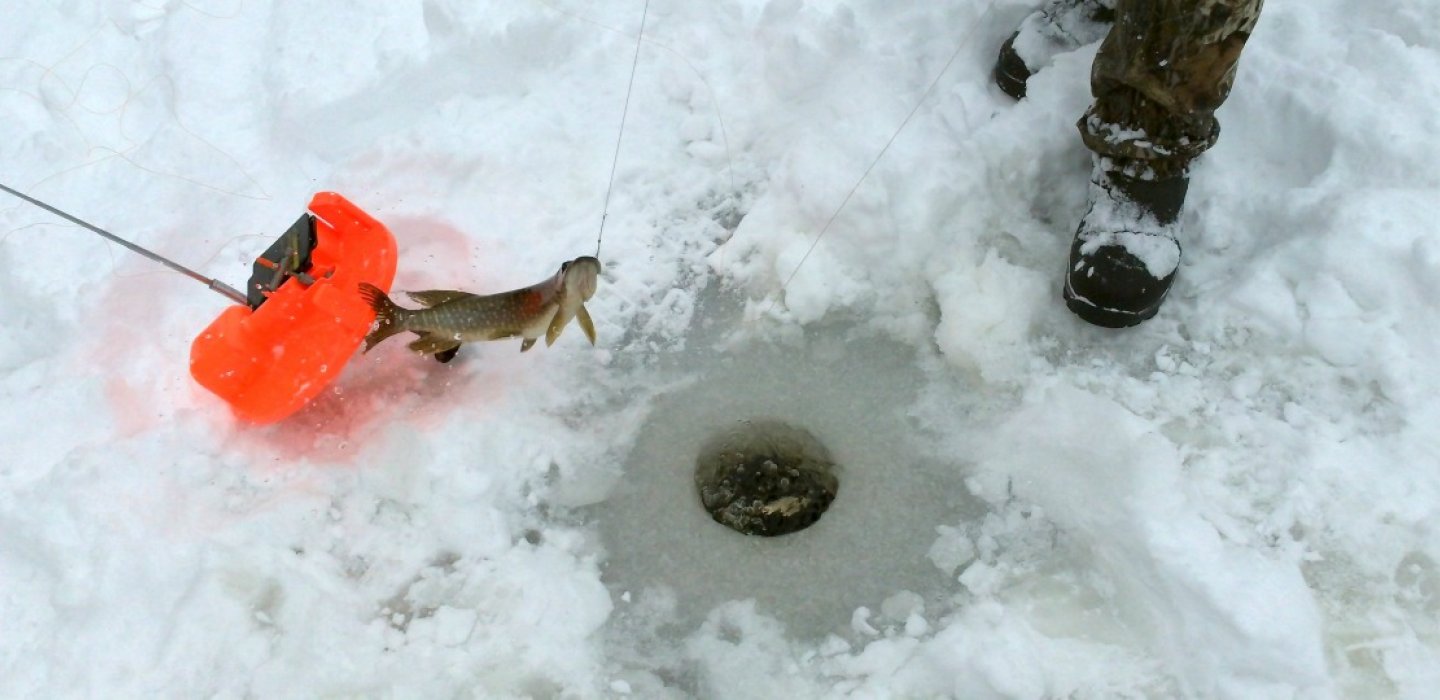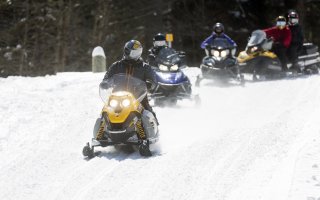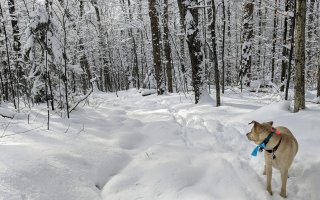
Ice fishing is probably as old as fishing itself. Why should any angler let several inches of ice stop them from fishing? In fact, we want at least four inches for walking on, five inches for a snowmobile or ATV, and eight or more for vehicles. A foot of good clear ice is needed for a medium-sized truck.
Fortunately, that's not usually a problem. Our Adirondack lakes and ponds really get lively from January into March, with whole "towns" springing up for a fun day on the ice.

Along with the usual cold weather clothing, it's important to have a good "ice fishing hat." While hoods are great for keeping us warm, they have drawbacks when scanning the ice for the popped flag that says we got a bite. Turning our head in a hood gives us a good view of the inside of the hood.
You want a hat and the hood, especially first thing in the morning and last thing at night. Though one of the surprising things about ice fishing is how not-cold it can be. A bright sunny day, with little wind, and we don't need too many layers, even with the sitting around and visiting which is also part of the fun of ice fishing.
early icing
Jones Pond is a popular spot, a 120-acre pond with plenty of the fine ice fishing species of Northern pike, yellow perch, and pumpkinseed. (Remember, if we catch anything else, they must be released as soon as possible; head first back into the hole. Head first lets the fish propel itself forward into the water and not get trapped. They cannot swim backward.)
It is in a very cold area and ices over early in the season. It also has the attraction of excellent fishing near shore, with an easy walk from the parking area nearby, right out onto the ice.

Ice fishing is not a quick stop on the way to other things. If we are not going to be there all day, we at least do 5-6 hours, a morning or afternoon's worth. While the minimum furnishing is a bucket to sit upon, most prefer a pop-up shanty, a brazier to cook fish at its freshest (up on legs to keep the hot metal away from the ice), and a cooler full of food and drink.
Ice fishing is not a lonely activity. While we are waiting for the flag to pop on the tip-up (seen below, in orange) there's considerable telling of stories, as with any fishing trip, but there is also wandering around to meet and greet the other folks out on the ice.

Two thirds of the Jones Pond shoreline is the Debar Mountain wild forest to the west, and the pond is fed by the St. Regis River. Even with the road at our backs and so many people enjoying the day, there is a wild feeling about Jones Pond.
the big ONE
Meacham Lake is the place to come for "big bruiser" Northern pike that reach over 30 inches in length. Chances are best along the southern shore. Other species allowed for ice fishing are yellow perch, pumpkinseed, landlocked salmon, smelt, and brown trout.
It also has good-sized splake (a type of trout) that run two to four pounds in size, from annual stocking with two to three thousand splake from the fish hatcheries. This is a managed, two story lake; a lake deep enough to support warmwater fish in the upper layer and coldwater fish, such as trout, in the deep, cold water below.

In February there is a fishing derby where there are crowds out on the ice. There's plenty of room, and trails fan out from the campground if we want a woods walk instead of a snowy vista. Meacham is a popular camping spot in the summer. Winter transforms it into a wildly different landscape.
Fishing derbies are a great way to try out ice fishing. We can join the sudden village that has sprouted on the ice, and observe the wide variety of preferred shelters, vehicles, and seating. We can see just how big the fish can get with so many experts vying with each other to win.

Meacham Lake has some very deep areas, so while it has a reputation as a challenging water body, when we hit, we hit big.
lots of action!
Osgood Pond is known for being a lively place for Northern pike. For some reason, this 500-acre pond is known for its hungry fish and a lot of "toothy action." Back in the early 1850s, a trio of young men camped there all winter in a log cabin. They did so well with their hunting and trapping that they showed their gratitude by naming the pond after the first person to try farming in the area: Arthur Osgood.
Today, our guides say "use big bait" to get the big pike. To keep those pike, they need to be at least eighteen inches long, with a daily limit of five. A popular tactic is to use some of the smaller perch we catch -- the big ones can go a foot long. Perch have a daily limit of fifty, any size.

Yellow perch appeal to children; even very young ones. Pike are generally larger and more imposing, and these are the apex predators in the lakes. They get their size from eating whatever they can catch, so make sure we do the fish handling ourselves. This glove-less operation is too tricky for children in any case.
Even while standing on a foot of ice, a bright sunny day on a snowy field can be surprisingly warm. Don't be surprised to see what looks like a picnic out on Osgood, which is a mix of public and private land and beckons with wild enjoyment winter or summer.

Whether we are packing up our own gear for a wonderful trip, or gathering a group to give ice fishing a try, we have the ponds and lakes that will give satisfaction.
Don't forget that hat.
Choose some cozy lodging. Explore more ice fishing. If we are new to ice fishing, get expertise and equipment with an Adirondack guide.
Meacham Lake Derby photos courtesy Alexander MacDonald Fish & Game Club.
This week in related ADK ice fishing news:






Comments
Add new comment